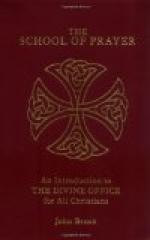Matins on account of its length and position in the Breviary is the most important part of the daily Office. And, on account of the variety and beauty of its elements, is considered the most remarkable.
The prayer Pater Noster begins the Office. It is the Lord’s prayer, divina institutions formata, when Christ told His Apostles “Sic vos orabitis” (St. Matt. vi. 9). It is the most excellent of all prayers, being most excellent in its author, its form, its depth of meaning, its effects. The prayer consists of a preface, “Our Father, Who art in heaven, hallowed be Thy name, Thy Kingdom come, Thy will be done on earth as it is in heaven.” And in the body of the prayer are seven petitions—three for the honour and glory of God, in and by ourselves, and four for our own wants, spiritual and temporal. Very excellent matter on the greatest of prayers is to be found in the Catechism of the Council of Trent (translation, Duffy, Dublin) and in A Lapide (St. Matt. vi.). Writers on liturgy say that the recitation of the Pater Noster as the opening prayer of Matins was not obligatory until the beginning of the twelfth century. It is said that the monks were wont to say a Pater Noster at each altar in the church before entering their stalls for Office recitation. This practice delayed the beginning of the Office in choir, and a rule was made that those who wished to say this prayer must say it in their stalls, in a low tone. Of course, in the Breviary of Pius V. (1568) this practice became obligatory on each person bound to read the Hours.
Ave Maria. This is a leading prayer amongst the great prayers of the Mass and the Office. It, too, is excellent in its authors, its form (clear, short devotional), in motive (in honouring Mary, Mother of God, and in begging her intercession). It is divided into three parts, the words of the angel, of St. Elizabeth and of the Church, Devout thoughts on this prayer have been penned by countless clients of Mary in every age. Priests are familiar with many such writings, great and small, but A Lapide (St. Luke I.) bears reading and re-reading. The prayer, as it stands in the Breviary to-day, is not of very ancient date. “In point of fact there is little or no trace of the Hail Mary as an accepted devotional formula before 1050.... To understand the developments of the devotion, it is important to grasp the fact that the Ave Maria was merely a form of greeting. It was, therefore, long customary to accompany the words with some external gesture of homage, a genuflexion, or at least an inclination of the head.... In the time of St. Louis the Ave Maria ended with the words benedictus fructus ventris tui: it has since been extended by the introduction both of the Holy Name and of a clause of petition.... We meet the Ave as we know it now, printed in the Breviary of the Camaldolese monks and in that of the Order de Mercede C. 1514. ... The official recognition of the Ave Maria in its complete form, though foreshadowed in the Catechism of the Council of Trent, was finally given in the Roman Breviary of 1568” (Father Thurston, S.J., Cath. Encyclopedia, art. “Hail Mary.”)




